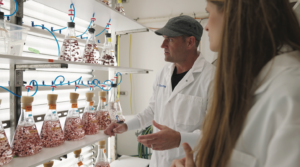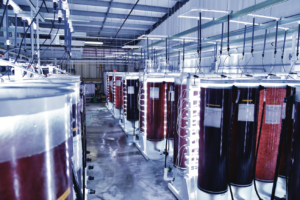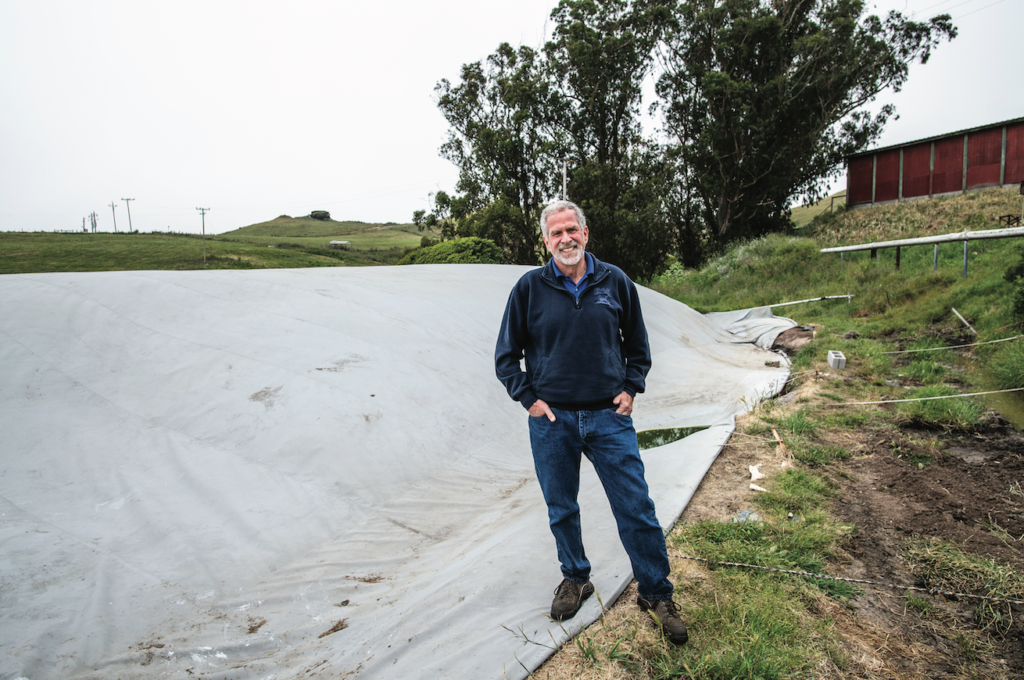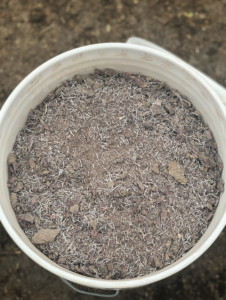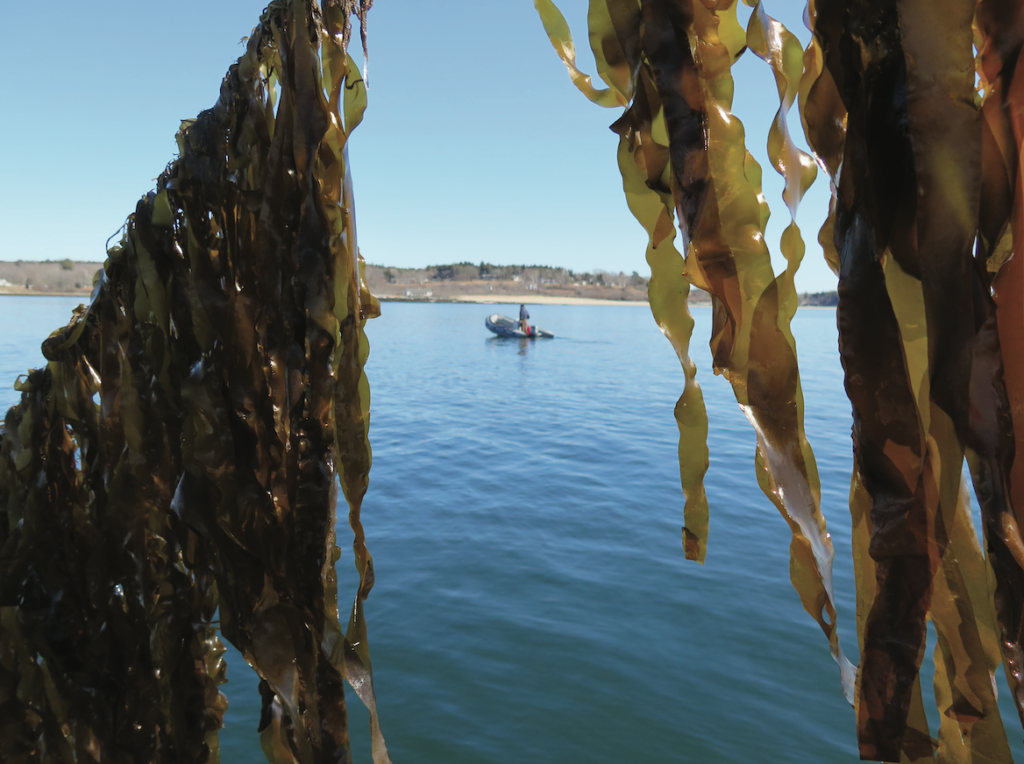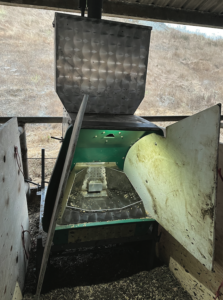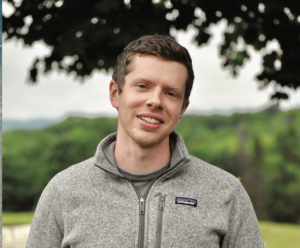
Cows enjoying seaweed feed at Straus Dairy Farms
Cows produce a ton of methane, a fact that weighs heavy on the dairy industry’s tortured brow. The greenhouse gas is the second largest contributor to climate change after carbon dioxide, and cows can’t help but release a huge percentage of the global output. Farmers have gotten creative, installing digesters that capture gas from the cow’s backside, but the majority of bovine methane emissions are coming out the other end in the form of planet-warming burps.
This problem has followed Joan Salwen around her entire life. The granddaughter of Iowa farmers, Salwen grew up in awe of her grandpa’s care for his animals and could never quite reconcile that image with the noxious stats she heard about their emissions. A decades-long career in education and consulting took Salwen away from the family farm, but this impregnable question hounded her and was at the top of her mind when she accepted a research fellowship at Stanford University in 2016. It was there, poring over academic journals one night, that she came across an article that would change her life—and possibly the global livestock industry.
The paper Salwen found detailed a small Australian study that had produced a whopping 99 percent reduction in methane emissions from cow burps by feeding the animals a red seaweed called Asparagopsis taxiformis. Native to warm waters the world over, A. taxiformis is known as limu kohu (or red sea plume) to Hawaiians, who sprinkle it on poke. These fern-like algae grow in swaying fronds at the edge of reefs, and turn into a deep ruby fluff when dried. What the Australian study was saying—that this innocent, Muppety substance was capable of almost completely blocking methane production in a cow’s gut—definitely seemed too good to be true. But Salwen needed to be sure—and she figured if anyone in the US would know, it’d be Ermias Kebreab.
Kebreab teaches at the University of California, Davis’s Department of Animal Science and chairs the United Nations Food and Agriculture Organization’s subcommittee on feed additives. A. taxiformis wasn’t on his research agenda yet, so Salwen asked if he’d be willing to explore it with her if she fundraised some support. He agreed, with a few caveats. “He said, ‘Please don’t tell anybody that we’ll be able to match 90 percent reduction,’” Salwen recalls. “‘If you need to set expectations, think about 15 or 20 percent as being enormously significant and dramatic and breakthrough.’” Even with the lower estimates, they secured the funding for a proof-of-concept that began in flasks and beakers (for animal welfare reasons), then graduated to a robotic cow stomach called a RUSITEC (rumen simulation technique). When no adverse effects were detected, they moved on to live dairy cows—but Salwen wasn’t counting her chickens. “I really am an optimistic and glass-half-full person, and yet I was reticent to declare victory too early,” she says.
Kebreab was certain the reduction benefits would diminish over time, while Salwen wanted to see if if efficiency gains would be made that could make the product more appealing to farmers. (A. taxiformis works by blocking the conversion of hydrogen and carbon into methane in a cow’s stomach, so it was possible that barring that reaction could leave behind valuable unused energy.) It wasn’t until their 147-day beef trial in 2019 that they started to realize this might actually work. “During [that] trial, we did see that cattle were able to maintain their weight gain rate. They were eating a little bit less feed overall, they were just making better use of [it],” Salwen says. It was also during this trial that they realized methane reductions not only persisted over time, but actually got better. Taste testers at Organic Valley headquarters in Wisconsin were finding no impact on the flavor of the milk, and similar tests were reporting zero change in beef tenderness or flavor; external research in Australia and Pennsylvania mirrored these results. It was time for the first US commercial dairy trial, which took place in the summer of 2021 at Straus Family Creamery.
Albert Straus has made it his lifelong mission to keep dairy farming viable (a fact we’ve reported on in this magazine). At his creamery and farm in Marshall California, he’s created a carbon-neutral model that strives not just to reduce climate change, but reverse it via composting, rotational grazing, methane digesters, and electric vehicles—so it was only natural that he would host the first commercial trial of Joan Salwen’s new company, Blue Ocean Barns. Last August, Straus separated two groups of cows from his main herd and began adding a quarter pound of seaweed to each cow’s 45-pound daily ration. Blue Ocean Barns and the team at UC Davis set up self-service GreenFeed machines to measure the cows’ methane output, using alfalfa cookies as bait. Over the two months that followed, the team watched as results came in, showing methane reductions ranging from 52 percent to 90 percent—a huge success. When I spoke to Straus in December 2021, he was planning to start feeding his cows the supplement as soon as it achieved state-wide approval, and he’s not the only interested cheesemaker. Over in Modesto, California, Brian Fiscalini of Fiscalini Farms is cautiously considering a trial, though he’s wary of disrupting his high-producing herd.
“If one or two ingredients are off, we can run into problems that take time to recover from. I think we still have a lot to learn about these feeds,” he says, reflecting the reality that selling the product to farmers could be the biggest hurdle Salwen will have to overcome. “Most dairy farmers are not going to spend money on a feed product that does not also improve components in the milk,” Fiscalini says. “I think that speaks more to thin margins in the dairy business and not to the farmers’ commitment towards sustainability.”
Indeed, a frequent sticking point for detractors is the environmental impact of growing, drying, and transporting as much seaweed as would be necessary to produce significant methane reduction. “Where’s the seaweed coming from?” This is the question George Crave of Crave Brothers Farmstead Cheese asked me, and he wasn’t the only one. Crave runs a methane digester on his farm in Waterloo, Wisconsin, and cares deeply about sustainability, but he’s not convinced that A. taxiformis is the solution. “A lot of the cows in the country are milked in Kansas, Utah, Idaho,” Crave says. “We have corn and soybeans and alfalfa right out our back doors, you know? The seaweed’s not out our back door.”
Or at least it isn’t yet. At the Bigelow Laboratory for Ocean Sciences in East Boothbay, Maine, ecologist Nichole Price is prototyping a tank that could grow microalgae on site at a dairy farm, using natural farming byproducts to fertilize growth. “So in fact,” Price says, “the shortest transportation distance will be for those farms in the middle of the country!” Price’s team replicates ocean conditions by adding nutrients to the tank culture, creating an environment that also protects the plants from contaminants like heavy metals. Her team’s working hypothesis is that pairing these fast-growing microalgae from interior states with native ocean-farmed algae that require no excess water or fertilizer could vastly expand the scalability of the seaweed solution.
This tank-to-table model would dovetail nicely with the “eat local” ethos of the artisan cheese industry, with its emphasis on how local flora and fauna infuse animal milk. “There’s terroir and there’s merroir,” Joan Salwen says. Her company grows A. taxiformis in vertical tanks using deep sea water near the coasts of Kailua-Kona, Hawaii, and San Diego, California. Though excited about the growth potential in Price’s research, Salwen expressed an inexplicable pull toward algae grown at sea. She pointed to the example of wine grapes: “Where they grow matters, and I feel that way about our seaweed.”
To assess how this merroir might affect cheese (especially the name-controlled and heavily regulated elders of the European artisan world), I turned to Matt Benham, a cheesemaker at Jasper Hill Farm who has also cut curd at Beecher’s Handmade, Mozzarella House, and Arethusa Farm. Benham used his 2020 Daphne Zepos Teaching Award to study how feed practices contribute to the expression of particular cheeses, so he seemed well-situated to consider seaweed’s potential role. “I don’t think that the use of these products inherently represents a step back for the industry,” he says. “There’s a lot of emphasis placed on tradition and typicity in the international artisan cheese community, [but] it’s important to recognize that even those cheeses that we consider to be traditional have undergone evolution over a number of decades in response to changes in farming context, regulatory climate, or technological evolution.” Benham raised the example of Stilton, which predates pasteurization but now must be pasteurized by definition. “Likely, within a few years, there will be debates among AOP producer groups as to whether to permit one supplement or another in their feed regimen… It may take longer for that adoption to occur in the artisan cheese community, but I think ultimately it will.”
MONEY TALKS
Few will say how much any of this is going to cost (or who is going to pay for it) yet, but there’s no such thing as a free seaweed lunch. We asked a few of the different players to weigh in on the money question.
“It may be the right thing to do, but until we’re able to effectively communicate to the average supermarket consumer that a given product is more ecologically responsible than the product beside it, then we’re going to struggle to monetize the additional effort/expense associated with some of these supplements or additives.” —MATT BENHAM, JASPER HILL FARM
“Most farmers are free enterprise people where we’re not really waiting for the government to come up with plans for us, but realistically if our energy and our environment are of real national, international, world interest, then maybe there should be some types of subsidies or incentives…because we just can’t do it ourselves.” —GEORGE CRAVE, CRAVE BROTHERS FARMSTEAD CHEESE
“Potentially the pressure for companies such as Burger King or Starbucks to reduce their footprint will push them toward supporting their farmers to use feed additives. A carbon trading scheme [could] also help in further adoption of feed additives worldwide.” —ERMIAS KEBREAB, UC DAVIS/BLUE OCEAN BARNS
FRIENDLY COMPETITION
Alongside Blue Ocean Barns, many climate-conscious players are engaged in a virtuous (and ever-so-slightly capitalist) game of one-upsmanship. While most report smaller methane reductions than A. taxiformis, this is one game where, no matter who wins, we all win.
Kowbucha: From veteran global dairy coop Fonterra, this feed additive works via methane-busting probiotic strains.
Bovaer: DSM’s Bovaer employs a methanogenesis inhibitor called 3-NOP that’s been approved for use in Brazil and Chile, with European clearance forthcoming.
Zelp mask: This bovine wearable from London-based start-up Zelp converts methane into CO2; they’re currently partnering with Cargill to test the halter on UK farms.
Vaccines: Fonterra is also developing a vaccine that would, in theory, introduce antibodies that inhibit the conversion of hydrogen into methane.
Flax: Several studies have shown that adding a little bit of flax to a cow’s feed reduces methane output by 10 to 20 percent.
Mootral: These garlic- and citrus-infused feed pellets are made by a Swiss-British company that claims their product cuts methane by 30 percent.
Agolin: An essential oil blend composed of coriander, clove, and carrot oils, Swiss-made Agolin has shown 10 percent methane reduction in cows fed 1 gram per day.


